Derby's Heritage Part 06 - Jury to Jurys
w/e 27 June 2010
All this week's pictures were taken
with a Kodak DX6490
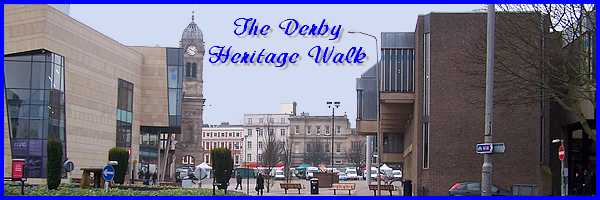
It took a while to decide on the title "Jury
to Jurys" for this part of the walk but then I realised
it started on Jury Street and ended near the new Jurys Hotel.
For the most part, the route along Walker Lane and Cathedral
Road is running in the opposite direction and parallel to St
Mary's Gate that we followed in Part 5 returning us almost to
Derby Cathedral but then we turn away from the cathedral and
proceed along Queen Street.
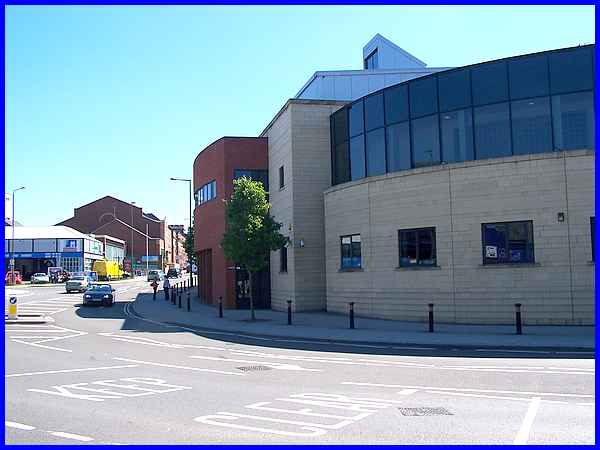
With Jury Street to the right and Walker Lane in front, the building
on the corner is the rear of the Magistrates' Court, the impressive
seventeenth century stone frontage of which we admired from St
Mary's Gate in the previous part. This rear view serves as a
good example of how new architecture can be merged with existing
structures without detriment to the old .
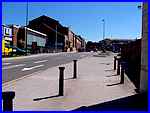 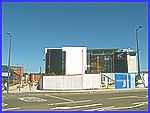 There are however several plots in
this area where buildings have been demolished. To the left,
hoardings form the boundary of one plot but standing beyond is
the Joseph Wright Centre which opened in 2005.
Part of Derby College it is named after Derby's famous eighteenth
century artist. Our route though lies directly ahead along Walker
Lane immediately leading into Cathedral Road (right). There are however several plots in
this area where buildings have been demolished. To the left,
hoardings form the boundary of one plot but standing beyond is
the Joseph Wright Centre which opened in 2005.
Part of Derby College it is named after Derby's famous eighteenth
century artist. Our route though lies directly ahead along Walker
Lane immediately leading into Cathedral Road (right).
|

The main building on Cathedral Road is the Queen's Leisure Centre
which originally opened as the Queen Street Swimming Baths on
July 30 1932. Built at a cost of £79,250 it was designed
by Charles Aslin, the Borough architect and in 1949 it played
host to the National Swimming Championships. It also became the
1500 seater King's Hall during winter months when the pool was
boarded over but despite several upgrades it closed in 1989 for
three years to undergo a major refurbishment. It was during this
time that the new entrance on Cathedral Road was created replacing
the original Queen Street access and when reopened it also had
a new name. The origin of the new name, the Queen's Leisure Centre,
is due to the official opening being conducted by Queen Elizabeth
II in April 1992 and not because of its previous link with Queen
Street.
|
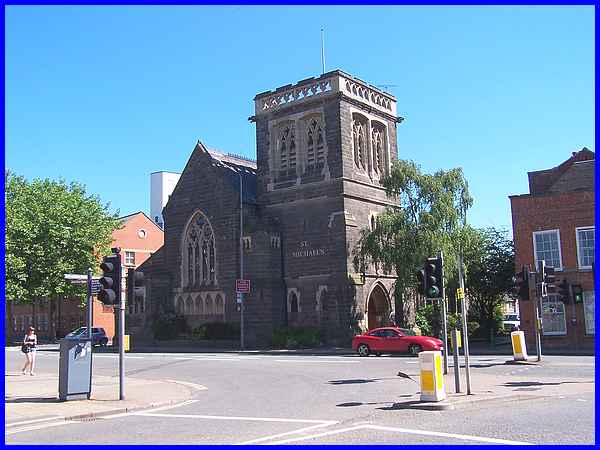
Cathedral Road ends at a crossroads with Queen Street to the
left and the first building that becomes visible as we approach
is St Michael's. I hesitate to say St Michael's "Church"
as it has now been converted into offices but a church had been
here since the time of the Domesday Book. During the eighteenth
century it was used as a waterworks but a new church was built
after the east gable fell in during a service in 1856. Designed
by H. I. Stevens it was built in 1858 and is faced with stone
to imitate the style of the thirteenth century. The large white
tower block just visible to the left and behind St Michael's
is the new Jurys Hotel.
|
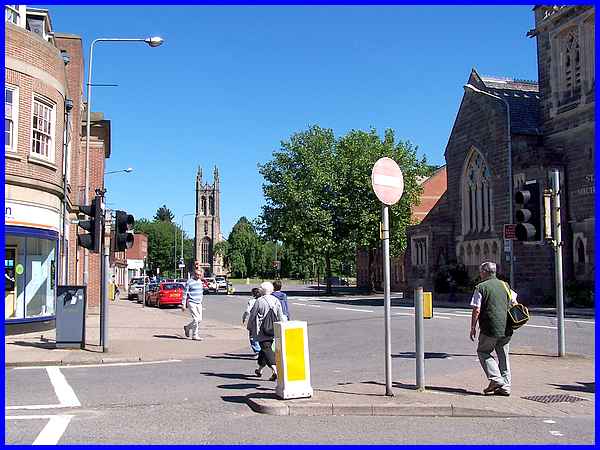
It is not surprising to find that St Michael's seen here on the
right of this image is no longer a church as it is sandwiched
between the cathedral just a few steps away along Irongate and
St Mary's Roman Catholic Church not much further away in the
other direction along Queen Street.
|

Our route is towards St Mary's but first we must pause to consider
two more buildings visible from the crossroads. Directly ahead
is Full Street and to the right is Irongate. The building on
the corner of the two roads and worthy of closer inspection is
the timber framed Olde Dolphin Inne, Derby's oldest public house.
|

Standing in the shadow of the cathedral, the inn bears a sign
showing the date 1530 and although the building dates back to
that time, the first licence to sell alcohol was not issued until
1580. Derby is known as the ghost capital of England and there
are several stories linked to the Dolphin including one where
a blue lady walks through the walls and who has been seen by
many customers. An extension to the inn in Full Street used to
be a doctor's house and another story tells of how he used to
dissect the bodies of criminals who had been hung although sometimes
it is said, they were not all dead. Many bodies though were dissected
in the Dolphin's cellar and it is now reported that it is haunted
by a poltergeist that turns the taps of the beer kegs off.
|
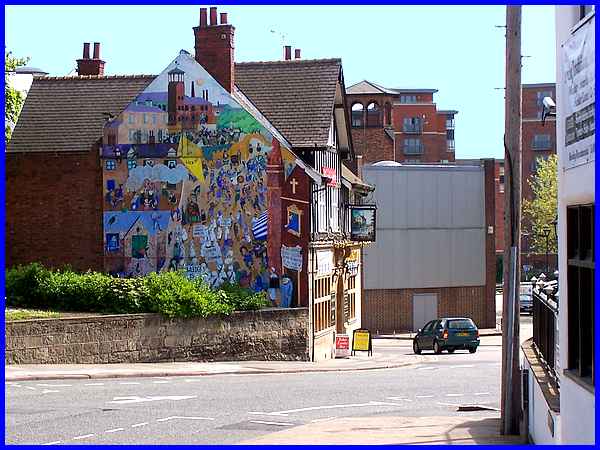
In crossing the end of Full Street, it is worth noting the Old
Silk Mill pub. Although our proposed route will return from a
different direction towards the pub it is from this angle that
the mural on the end wall can be best appreciated. The mural
painted by the Derby Community Arts Project in the mid 1980s
depicts the silk trades lock out of 1833 that lasted for some
eight months.
|
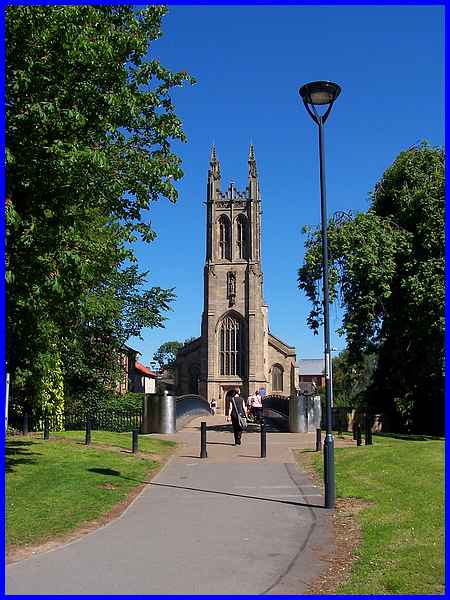
Continuing along Queen Street and crossing King Street we are
now approaching St Mary's Roman Catholic Church. Like many cities,
Derby has undergone much redevelopment during the twentieth century
to cater for an increased traffic flow and the inner ring road
now passes in front of the church. A new footbridge over the
road gives easy access to the church and an information board
titled "St Alkmund's Bridge and Derby's public realm strategy"
contains this opening paragraph: "The new foot and cycle
bridge over St Alkmund's Way has been installed through Derby's
Public Realm Strategy as part of the Heritage Walk from The Spot
to St Mary's Church. The route follows part of an ancient track,
older than the city itself that ran along the River Derwent and
connected the River Trent to the High Peak."
The church, built between 1838 and 1844 to a design by Augustus
Pugin, was his first major church and, completed by his son E.
W. Pugin, was financed by the 16th Earl of Shrewsbury, John Talbot.
It is unusual in that rather than the normal east-west orientation,
it lies on a north-south axis due to the confines of the site.
After crossing the bridge and turning right in front of the tall
Neo-Gothic Perpendicular tower, our route will now take us along
a footpath at the side of St Alkmund's Way and be overlooked
by the new Jurys Hotel and it is from here that we will continue
the walk in the next part.
|

